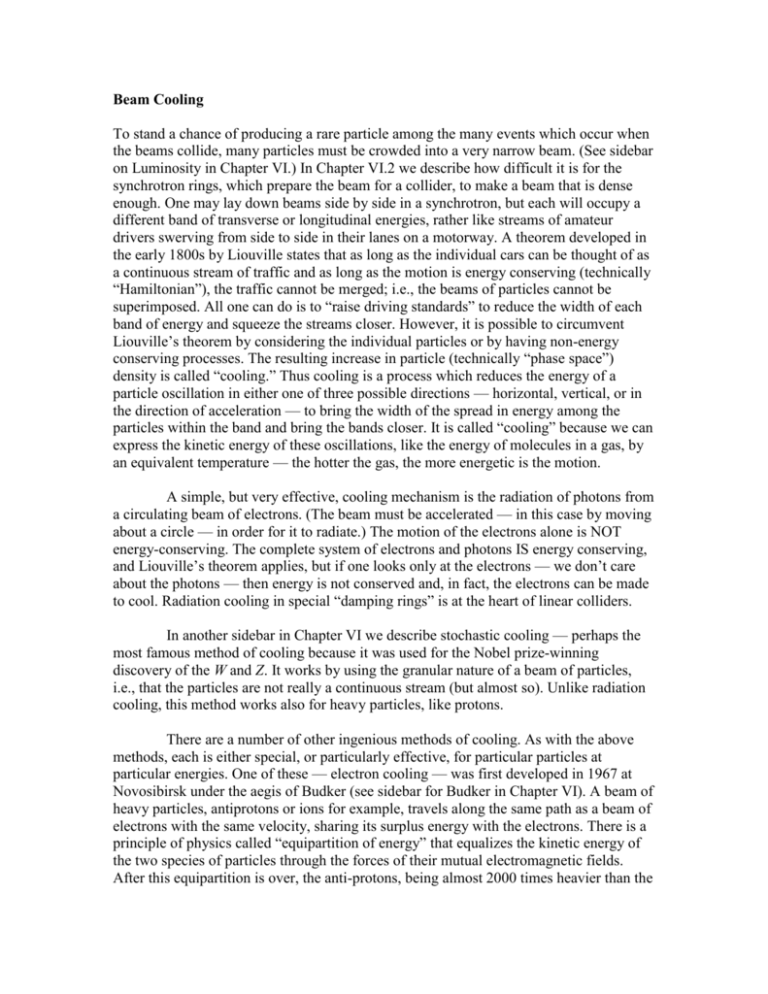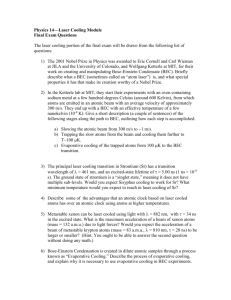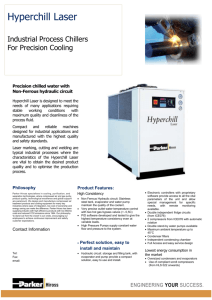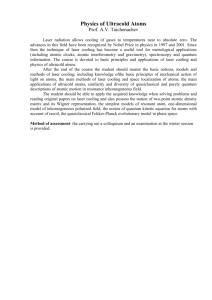Cooling
advertisement

Beam Cooling To stand a chance of producing a rare particle among the many events which occur when the beams collide, many particles must be crowded into a very narrow beam. (See sidebar on Luminosity in Chapter VI.) In Chapter VI.2 we describe how difficult it is for the synchrotron rings, which prepare the beam for a collider, to make a beam that is dense enough. One may lay down beams side by side in a synchrotron, but each will occupy a different band of transverse or longitudinal energies, rather like streams of amateur drivers swerving from side to side in their lanes on a motorway. A theorem developed in the early 1800s by Liouville states that as long as the individual cars can be thought of as a continuous stream of traffic and as long as the motion is energy conserving (technically “Hamiltonian”), the traffic cannot be merged; i.e., the beams of particles cannot be superimposed. All one can do is to “raise driving standards” to reduce the width of each band of energy and squeeze the streams closer. However, it is possible to circumvent Liouville’s theorem by considering the individual particles or by having non-energy conserving processes. The resulting increase in particle (technically “phase space”) density is called “cooling.” Thus cooling is a process which reduces the energy of a particle oscillation in either one of three possible directions — horizontal, vertical, or in the direction of acceleration — to bring the width of the spread in energy among the particles within the band and bring the bands closer. It is called “cooling” because we can express the kinetic energy of these oscillations, like the energy of molecules in a gas, by an equivalent temperature — the hotter the gas, the more energetic is the motion. A simple, but very effective, cooling mechanism is the radiation of photons from a circulating beam of electrons. (The beam must be accelerated — in this case by moving about a circle — in order for it to radiate.) The motion of the electrons alone is NOT energy-conserving. The complete system of electrons and photons IS energy conserving, and Liouville’s theorem applies, but if one looks only at the electrons — we don’t care about the photons — then energy is not conserved and, in fact, the electrons can be made to cool. Radiation cooling in special “damping rings” is at the heart of linear colliders. In another sidebar in Chapter VI we describe stochastic cooling — perhaps the most famous method of cooling because it was used for the Nobel prize-winning discovery of the W and Z. It works by using the granular nature of a beam of particles, i.e., that the particles are not really a continuous stream (but almost so). Unlike radiation cooling, this method works also for heavy particles, like protons. There are a number of other ingenious methods of cooling. As with the above methods, each is either special, or particularly effective, for particular particles at particular energies. One of these — electron cooling — was first developed in 1967 at Novosibirsk under the aegis of Budker (see sidebar for Budker in Chapter VI). A beam of heavy particles, antiprotons or ions for example, travels along the same path as a beam of electrons with the same velocity, sharing its surplus energy with the electrons. There is a principle of physics called “equipartition of energy” that equalizes the kinetic energy of the two species of particles through the forces of their mutual electromagnetic fields. After this equipartition is over, the anti-protons, being almost 2000 times heavier than the electrons, will only retain about one fiftieth of the velocity spread of their lighter companions and, if the heavier particle originally had the lion’s share of the energy, it will be “cooled” by this factor of 50. At high intensity of proton or ion beams this kind of cooling is a much faster process than stochastic cooling, and is particularly effective when the proton, ion or antiproton beam is circulating at low energy. At first it was considered as a rival candidate to the stochastic method of cooling antiprotons for use in colliders, but stochastic cooling turned out to be much more useful at higher energies, large emittances and for a relatively small number of antiprotons. Recently electron cooling has been employed at the high-energy anti-proton recycler at Fermilab and it is being developed for high-energy ions at RHIC (Brookhaven). Laser cooling is another method and is also a fascinating practical application of modern physics. The idea is applied to a beam of ions circulating in a storage ring. The laser excites the ion from one direction, and the ion then radiates in an isotropic manner and so cools. (The violation of assumptions for the Liouville theorem is very similar to that in radiation cooling.) However the radiation must be exactly to the initial state, as the process must be repeated a million times to cool any one ion. Ions speeding towards the laser beam see the laser beam shifted in frequency and hence in photon energy — the Doppler effect. An ion of a particular and precise velocity can see photons whose energy exactly matches the difference in its electron energy levels. When such a resonance occurs, energy is transferred between the photon and the ion, speeding it up or slowing it down. The trick is to sweep the laser frequency, or the photon energy, backwards and then forwards into the distribution of velocities in the beam, squeezing it from both sides into a much narrower band. An alternative is to sweep the particle beam energy — often done with an induction unit. The separation of the quantum energy levels of the electrons orbiting the ions must be the same as the energy of the laser photons; and, most importantly, have only a ground state and one excited state connected by the laser photon. Only a few ions have these characteristics, but they have been cooled most effectively by this method. Yet another method is used for the beams for muon colliders. Muons offer a route to extend circular lepton accelerating storage rings to energies of several TeV, but the acceleration and storage must occur in a few milliseconds to compete with their rapid decay. Like antiprotons, the muons must be cooled. Because of the time constraints, single-pass cooling or perhaps cooling over a few passes, is the only solution. In the socalled “ionization cooling” method, particles pass through an energy absorbing plate and lose momentum in the direction of their trajectory to the electrons of the absorber material. (Thus the assumption of energy conservation, in Liouville’s theorem is violated.) If they are “hot” and therefore moving at a small angle to the axis of the beam, some of the transverse as well as longitudinal momenta will be lost. An RF cavity following the absorber replaces the longitudinal but not the transverse momentum. Repeated a few times, the process will cause a steady reduction of transverse momentum — reducing the angle of the path and cooling the beam. Longitudinal cooling can also be accomplished; it requires bending magnets. This approach is being actively studied at this time. Yet another method is used for the beams for muon colliders. Muons offer a route to extend circular lepton accelerating storage rings to energies of several TeV, but first the muons like antiprotons must be cooled, but in a time of a few milliseconds in order to competes with their rapid decay, with half life 2 microseconds. Single pass cooling, or perhaps cooling over a few passes, is the only solution. In the so-called “ionisation cooling” method particles pass through an energy absorbing plate and lose momentum in the direction of their trajectory to the electrons of the absorber material. (Thus the assumption of energy conserving, in Liouville’s theorem, is violated.) If they are “hot” and therefore moving at a small angle to the axis of the beam both some of the transverse as well as longitudinal momenta will be lost. An RF cavity following the absorber replaces the longitudinal momentum but not the transverse. Repeated a few times, the process will cause a steady reduction of transverse momentum – reducing the angle of the path and cooling the beam. Longitudinal cooling can also be accomplished; it requires bending magnets. This approach is being actively studied at this time.







